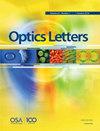半导体量子点单光子散射声控制的精度。
IF 3.3
2区 物理与天体物理
Q2 OPTICS
引用次数: 0
摘要
量子点(QDs)的声学调制允许人们控制光子的散射。在这里,我们从理论上表征了这种声学控制在频域的程度。我们在存在白噪声的情况下制定了低强度共振荧光(RF)理论,并表明,只要噪声诱导的相位扩散系数保持比声频小一个数量级,就可以通过适当设置调制幅度的双音声场实现高水平的控制。此外,利用光信号收集的定量模型,我们确定声相位必须在104到105声周期内保持稳定才能有效控制。本文章由计算机程序翻译,如有差异,请以英文原文为准。
Precision of the acoustic control of single-photon scattering with semiconductor quantum dots.
Acoustic modulation of quantum dots (QDs) allows one to control the scattering of photons. Here we theoretically characterize the degree of this acoustic control in the frequency domain. We formulate the theory of low-intensity resonance fluorescence (RF) in the presence of white noise and show that a high level of control is achievable with a two-tone acoustic field for appropriate settings of modulation amplitudes as long as the noise-induced phase diffusion coefficient remains one order of magnitude smaller than the acoustic frequency. In addition, using a quantitative model of optical signal collection, we determine that the acoustic phase must be stable over 104 to 105 acoustic periods for efficient control.
求助全文
通过发布文献求助,成功后即可免费获取论文全文。
去求助
来源期刊

Optics letters
物理-光学
CiteScore
6.60
自引率
8.30%
发文量
2275
审稿时长
1.7 months
期刊介绍:
The Optical Society (OSA) publishes high-quality, peer-reviewed articles in its portfolio of journals, which serve the full breadth of the optics and photonics community.
Optics Letters offers rapid dissemination of new results in all areas of optics with short, original, peer-reviewed communications. Optics Letters covers the latest research in optical science, including optical measurements, optical components and devices, atmospheric optics, biomedical optics, Fourier optics, integrated optics, optical processing, optoelectronics, lasers, nonlinear optics, optical storage and holography, optical coherence, polarization, quantum electronics, ultrafast optical phenomena, photonic crystals, and fiber optics. Criteria used in determining acceptability of contributions include newsworthiness to a substantial part of the optics community and the effect of rapid publication on the research of others. This journal, published twice each month, is where readers look for the latest discoveries in optics.
 求助内容:
求助内容: 应助结果提醒方式:
应助结果提醒方式:


